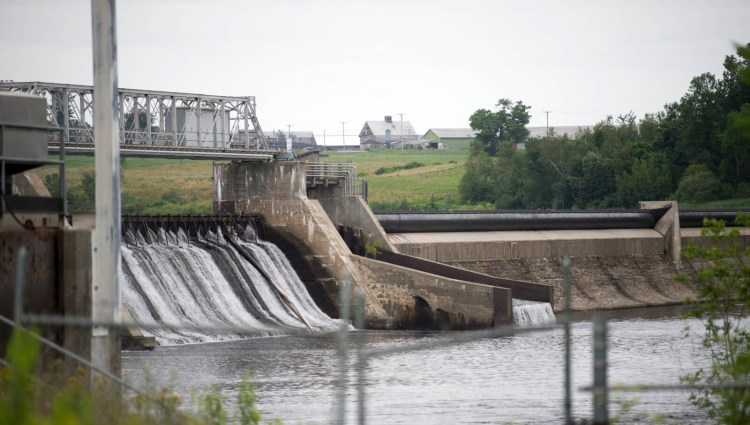Federal regulators said this week that they will conduct a comprehensive environmental review of the cumulative effects of four lower Kennebec River dams on the endangered Atlantic salmon and other sea-run fish.
The move by the Federal Energy Regulatory Commission has been long sought by a coalition of conservation groups that have been fighting to have one or more of the lower Kennebec dams removed to help fish reach prime habitat in western Maine’s Sandy River, a position shared by the Mills administration.
“This is a very favorable development because it has FERC asking the right questions, which are what are the cumulative impacts of all four dams,” says Jeff Reardon of Trout Unlimited and spokesperson for the Kennebec Coalition, a group of environmental groups fighting the dams. “If you look historically, the last two times we got multi-dam environmental impact studies, dam removals followed,” he said, referring to the removal of the Edwards Dam farther down the Kennebec and two dams on the Penobscot River.
FERC’s decision is a key development in the multifront war over the future of fish runs in western Maine’s largest river system and the survival of endangered Atlantic salmon in the United States.
The conflict pits the state of Maine and the Kennebec Coalition – Trout Unlimited, the Natural Resources Council of Maine, the Atlantic Salmon Federation and Maine Rivers – against the dams’ owner, the renewable power subsidiary of Brookfield Asset Management. Brookfield is an Ontario-based global asset manager with $60 billion in annual revenue and $600 billion in assets, including 5,300 hydropower dams worldwide, 38 of which are in Maine.
The dams – the Shawmut in Fairfield, the Hydro Kennebec and Lockwood in Waterville and the Weston dam near Skowhegan – effectively block salmon from accessing the Sandy’s pristine spawning habitat, the conservation groups say. Brookfield has argued that building or improving fish passages will remedy the situation while continuing to provide clean power.
“Unfortunately, this latest shift will result in additional delays in the implementation of fish passage improvements on the lower Kennebec and uncertainty for the local communities,” Brookfield Renewable spokesperson Julie Pelletier said via email. “Brookfield Renewable remains committed to installing state of the art fishways at the lower Kennebec River facilities, including Shawmut Dam, and we are confident the EIS process will reinforce FERC’s prior findings that Brookfield Renewable’s proposed fish passage enhancements appropriately balance species restoration and the important economic contributions of the Shawmut Dam.”

The struggle centers on the once-in-a-half-century FERC relicensing of one of the dams, the Shawmut, which requires approval of water-quality standards from the state of Maine. Conservation groups say having access to the Sandy is the last chance for Atlantic salmon to survive in the United States.
In September, the Conservation Law Foundation and three Maine conservation groups sued Brookfield in federal court over alleged violations of the Endangered Species Act at the four dams. The conservation groups alleged that Brookfield has been killing Atlantic salmon at its dams on the Kennebec in violation of the law since Dec. 31, 2019, when its federal authorizations to kill salmon expired. The groups also have asked a court to issue an injunction to curtail operations at the dams they allege are harming the fish.
Brookfield fired back later in September with a separate suit in state court alleging that the Maine Department of Environmental Protection violated a binding 1998 water management agreement with the company. It argued that the Department of Marine Resources couldn’t work with other state government agencies to develop their positions, a stance Gov. Janet Mills’ office dismissed as “meritless” and “a disappointing demonstration of the company’s continued unwillingness to partner with the State of Maine to solve this serious issue.”
FERC intends to issue a draft of its environmental impact study for the dams in August 2022 and a final version in February 2023, according to the agency’s notice of intent dated Nov. 23.
Maine has been a nationwide leader in the restoration of river systems and the sea-run fish that spawn in them. With the removal of Augusta’s Edwards Dam on the lower Kennebec in 1999 and the Great Works and Veazie dams in the lower Penobscot in 2012 and 2013, alewives, shad, blueback herring and salmon had access to thousands of miles of river habitat for the first time since the early 19th century.
The alewife run into the Sebasticook, a tributary of the Kennebec made accessible by dam removals, is now the largest in the United States, with nearly 6 million fish, and a favorite bald eagle dining site.
Send questions/comments to the editors.



Comments are no longer available on this story